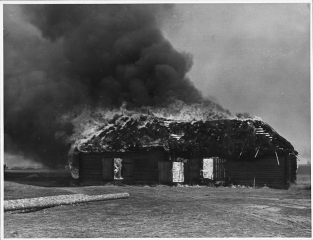After a short reminder to the opening of the exhibition “Dieter Keller (1909-1985): Photos von der Ostfront” (Photos from the Eastern Front) in the Berlin-based Gallery Berinson, we finally had the opportunity to see all the works. Traces of the Second World War are shown from the view of an artistically thoroughly able pacifist: the people portrayed – may they be alive or dear – all remain their dignity. After having seen countless photos from World War II, we do not know many others of similiar artistic quality.

Dieter Keller was publisher of the “Kosmos” Verlag in Stuttgart, Germany. He was friends with various artists of his time, e.g. with Willi Baumeister and Oskar Schlemmer. Keller, who politically tended towards Socialism and even Communism, admired the people of the Soviet Union and detested war. So much the worse was it for him to be part of a people that attacked others, killed and pillaged, and still felt superior. One result for him was to be as far away from combat action as possible and not to shoot by himself. He seems to have been successful with that approach. He even more so left his own troops several times and lived together with partisans, according to his own statements. His extensive field postal correspondence still lies unexamined at Stuttgart’s Staatsgalerie.
As far as it is known, the position of Keller’s troops at the Eastern Front mainly was the border area between Belarus and Ukraine. During his deployment at the Eastern Fron in 1941-1942, Keller took the pictures with a “Russian Leica” (presumably a Zorki) .
The landscapes appear to be painted: burning houses, rugged ground, a flower in dead earth. A picture of Russian POWs has been taken without the attitude of a “master race”: the men lean against a fance and could be workers. The portraits of Russian children equally show an open view that was returned: no “subhuman beings” are presented here, but young people in tattered clothes who glance roguish or self-confident. Even the dead remain their dignity, may it be a head overflown with maggots, or the sad relicts of a Red Army soldier: a single foot that looks like a sculpture. Similar and nearly aethetical the animals’ carcasses are being shown, may it be horses, cats or geese. A bust of Lenin is placed on the dusty ground, looking as if a body was buried up to his belly.
All these pictures are unified by the photographic and ethical view (without moralising) and the excellent image composition. These aspects also differentiate this exhibition from the usual snapshots soldiers brought home from war, not even to mention the absence of both (at least living) soldiers and romanticising the soldiers’ lives on the photos.
Dieter Keller was lucky: just before the fatal Battle of Stalingrad, he was shifted to Italy and thus could avoid his most likely death. After the war, he never spoke about his photos. In 1958/1959, all the negatives were destroyed by flames. Thus, the positives – all made by Keller himself – in the size of 18×24 cm (some 8×10″) are unique copies.
The collection of 203 photos is being offered in total; unhinging single pictures is fortunately not an option for the gallery. The Berinson Gallery is offereing a PDF document with all the pictures on request.
The excellent exhibition with a selection of 50 photos has now been extended until 18 December 2010 and is part of the 4th European Month of Photography (15 October – 28 November 2010).
Dieter Keller (1909-1985): Photos von der Ostfront
Galerie Berinson
Lindenstr. 34
10969 Berlin
Germany
16 October until 18 December 2010
Tu-Sa 1100-1800h





